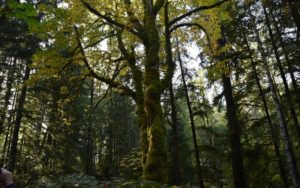 Each year when our forest leaders come together for MegaFlorestais—a forum for forest agency leaders from the world’s most forested countries—something different inspires and challenges me. The most recent meeting in Canada in October elicited a number of surprises, from innovations in forest products to the use of new technology to monitor forests. Big transformations are coming to the world of forestry, a sector generally known for being conservative and slow to change.
Each year when our forest leaders come together for MegaFlorestais—a forum for forest agency leaders from the world’s most forested countries—something different inspires and challenges me. The most recent meeting in Canada in October elicited a number of surprises, from innovations in forest products to the use of new technology to monitor forests. Big transformations are coming to the world of forestry, a sector generally known for being conservative and slow to change.
The game-changing technologies presented throughout the meeting, if used effectively by forest agencies, could result in better decisions for our world’s forests and forest people. Students from the University of British Columbia, along with FP Innovations—a Canadian nonprofit carrying out scientific research for the Canadian forestry industry—demonstrated the use of new innovations and technologies to solve intractable issues such as the high cost of forest monitoring. A representative from Brazil’s forest agency presented how the country is using technology to help rural families and communities map their property boundaries in a way that, just a few years ago, would have been impossible. Something akin to “Moore’s Law ” (an observation that the power of computers will increase exponentially as the numbers of transistors that can fit onto a silicon chip doubles every year or two) is at work in forestry, a reassuring message for me.
However, the lesson I was most struck by came from the way different stakeholders from the Great Bear Rainforest (GBR) were able to resolve a longstanding conflict over land and forest usage rights. As with many forests around the world, a “war” was being waged in the woods over how this part of British Columbia should be managed into the future. Everyone in the “battle” had a claim over the forest: corporations with government contracts to conduct logging; NGOs looking out for the greater public interest; indigenous tribes who had never ceded their territory; and the provincial government who claimed ownership and mediated conflicts. While the costs were high to address these issues—in both time and money—the resolution was inspiring. As countries around the world face polarization on so many fronts and in so many sectors, the case of the GBR offers fundamental lessons for the global forestry community:
First, assumptions about the interests and needs of other groups must be suspended. Judging intentions can result in further entrenchment and lead away from solutions.
Second, a forum that promotes real listening is essential to moving past these stereotypes. Each participant has to feel that every other participant is acting openly and honestly in the dialogue, with the intention of truly understanding one another. A “safe” environment for dialogue must be created. Only in this way can trust between participants be built. It cannot be commanded or directed—it must emerge from honest listening and dialogue.
Third, key to all of this is for each party to share their vision for the future, because it is around a common vision that diverse parties and their independent interests can collectively rally. For example, a healthy forest into the future can provide jobs, protect the environment, protect basic rights, and create new opportunities for all parties.
As I consider what appear to be intractable, polarized positions in the politics of many of our countries, I believe the actions of this collection of committed individuals in British Columbia can teach the world an important lesson. These issues are not impossible to solve if we infuse our political processes with some humanity. By treating those with opposing viewpoints with respect and developing empathy for their daily problems and challenges, those participating in GBR came to a common understanding. While this seems so simple, our governance structures are often more adept at responding to technical problems than building trust between communities and other stakeholders. What’s inspiring is knowing that forest agency leaders can lead in this process if we are willing to expend the time and energy to do so.
Sally Collins is the former Associate Chief of the U.S. Forest Service and has been serving as the MegaFlorestais Co-Chair since 2006. See her full biography here.
This article was originally published on the blog of the Rights and Resource Initiative on November 1, 2017.
Photo by Sally Collins
